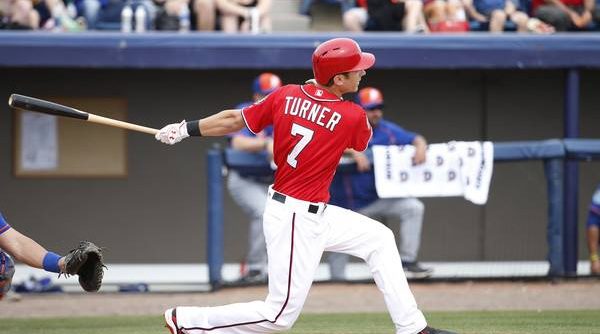When thinking about major leaguers, we consider a high BABIP an indicator of unsustainable performance. A guy running a .400 BABIP is sure to come back to earth (except maybe Daniel Murphy), and most everyone should be around .300.
It would follow logically that the same should be true for the minor leagues. Even if you want to argue that minor league defenses or pitchers would contribute to higher minor league BABIPs, a surprisingly relevant Baseball Prospectus article (from 2005!) shows that while BABIP is significantly higher in the very low minors, the effect is nearly gone at the highest levels of the minors: BABIP is .322 at AAA compared to .309 in the majors.
So what do we make of Trea Turner? You’ve surely heard of his offensive exploits in the minors: He’s a career .322/.385/.458 hitter in almost two full minor league seasons, with a .321/.386/.474 line at AAA Syracuse this year. With a bat like that, no wonder many want him to replace Danny Espinosa as the Nats’ starting shortstop.
But a closer look reveals something curious about those numbers. Turner has struck out 19.4% of the time in his minor league career, a high rate for someone who has such a high batting average and who hits such few home runs (16 in 225 career games). What enables Turner to have such a high batting average and overall offensive success despite the strikeouts and lack of power?
As you might have guessed from the introduction to this article, the answer is his BABIP. In his minor league career, Turner has a staggering .399 BABIP. And after 998 career plate appearances, it would be pretty hard to attribute that to luck.
But nobody in the major leagues could ever have such a high BABIP. If Turner’s game is so dependent on BABIP, does it mean he’s doomed to be unsuccessful at the major league level? For reference, if Turner had a .300 BABIP in the minors, he would be a career .246 hitter. To answer the question of what this means for his MLB future, we need to first think about why Turner’s BABIP is so high. His blazing speed is well-known, so let’s take a look at some similar speedsters to see if they had high minor league BABIPs.
Reds center fielder Billy Hamilton had a .356 BABIP in the minors, but there’s an important caveat here. As mentioned in the BP article above, BABIP is much higher in the low minors, where Hamilton (drafted out of high school) spent 3 ½ seasons and Turner (drafted out of college) spent just half of one. For the rest of our comparisons, we’ll use BABIP at AA and AAA. This exposes us to some small-sample concerns, but Hamilton has nearly 800 PAs at AA and AAA, while Turner has nearly 700. Turner’s BABIP at those levels is .394, keeping our point the same. But at the same stops, Hamilton’s is just .326, so it seems unlikely that speed is the driving force behind Turner’s BABIP.
Hamilton’s speed also hasn’t kept his BABIP high in the majors, as his career MLB BABIP is just .289. And if Turner’s bat ends up like Hamilton’s, he’s in trouble. Hamilton has a career 68 wRC+, and only his elite defense keeps him in the majors.
Marlins second baseman Dee Gordon is a closer example: He had a .352 career BABIP at AA and AAA (over 1392 PAs) and kept it up with a .345 BABIP in the major leagues. Turner is not exactly the same type of hitter as Gordon, as he will likely strike out more but will hit for significantly more power. Nevertheless, Gordon shows that a high BABIP can be maintained into the majors.
It’s hard to extrapolate from two examples, but Hamilton and Gordon can serve as a pair of important case studies. Between the two, we can see that speed is not the sole factor behind a high minor league BABIP, as neither player’s BABIP approaches Turner’s. From Hamilton, we know that speed is not sufficient to maintain a certain BABIP from the minors to the majors, though Gordon shows us that it is possible to keep up a high BABIP at the highest level. But wait, you say. Didn’t I just say everyone should have a BABIP around .300? How is that true if Gordon’s career BABIP is .345?
That brings me to my next point. The idea that all players should have a BABIP of around .300 is actually somewhat of a misconception. We do cry regression when we see players with a high BABIP, but there are actually 17 active players (min. 1000 PAs) with a career BABIP above .340. The active leader is Christian Yelich, with a remarkable .366 BABIP.
As one might expect, the players with the three best active BABIPs (Yelich, Mike Trout at .358, and Starling Marte at .357) all had stellar minor league BABIPs. Yelich and Trout were very highly rated prospects and spent very little time at AA and AAA, but they had overall BABIPs of .381 and .407 (!), respectively. Marte had a .370 BABIP in over 1000 PAs at AA and AAA, and a .370 minor league BABIP overall. Kris Bryant is 171 plate appearances shy of qualifying, but he would place second with his .361 BABIP. His major and minor league numbers should be taken with a grain of salt, given how few PAs he has had and how few balls he puts in play, but he had a .406 BABIP in 773 minor league PAs.
But just because the players with high MLB BABIPs had high MiLB BABIPs does not mean that the reverse is true. I was unable to find any sort of searchable database of minor league stats that would let me look at the minor league numbers of current major leaguers (if you find one, let me know!), so I wasn’t able to look at all of the guys who had minor league BABIPs as high as Turner’s and see how they fared in the majors. It would take a long time to comb through every major league hitter with a BABIP around .300 and see if any had amazingly high minor league BABIPs, but know that a high minor league BABIP is no guarantor of success. See Jesus Montero, who had a .349 BABIP in the minors and owns a .287 mark in the majors.
This is not intended to be an argument that all players with high minor league BABIPs do well in the majors, or even that they generally do well. But the examples here show that it is possible to depend on a high BABIP in the majors, and that a high BABIP in the minors can translate to the same in the majors. They also show us that a maintainable high BABIP like Turner has can be a legitimate skill, and that Turner’s BABIP is a lot more than a mirage built on his speed.
Even with these examples, Turner is somewhat of a unique case: Of the (admittedly very few) players I looked at, only Trout and Bryant were within 15 points of Turner’s BABIP, and Trout posted his numbers mostly in the higher-BABIP low minors, while Bryant has a somewhat small sample. As far as I can tell, Turner is an extreme outlier, meaning it’s hard to say what happens to players like him because there are very few players like him.
Here is where someone much more knowledgeable about scouting than I could tell you about Turner’s swing or his hit tool and how that relates to his balls in play, but I’ll leave that to them. For my part, I will say this: Through some combination of hitting the ball hard and being fast, Turner is consistently able to get hits when putting the ball in play a lot more frequently than other players. Other players have done the same in the minors and then reproduced it in the majors, and while I couldn’t find any examples, I’m confident that many have had very high minor league BABIPs and then failed to do the same in the majors. I don’t know how well minor league BABIP translates to the majors on the whole for outlier players like Turner, but I know the blueprint for this type of player exists, so I believe it is feasible that Turner could come to the majors and post a consistently high BABIP.
For what it’s worth, at least one projection system agrees. FanGraphs’ Steamer projection pegs Turner for a .353 BABIP — which would be the sixth-highest among active players — resulting in a .285/.332/.402 line and 101 wRC+, which I think most would be overjoyed with. Combined with his defense, it projects him for 0.4 fWAR in 94 PAs, which would prorate out to about 2.6 fWAR on a whole season. Consider this the high case.
Dan Szymborski’s ZiPS would then be the low case. It projects just a .323 BABIP for Turner, and along with a few more strikeouts and homers, gives Turner an expected .256/.308/.378 line. That line is a pretty solid impersonation of Danny Espinosa, though ZiPS somehow likes Turner more on the whole: It expects him to post 2.2 fWAR in 483 PAs, or about 0.2 more over a whole season than Steamer. Regardless, I would at least consider this Turner’s offensive low case.
I would love to be able to look at a larger set of minor league BABIP numbers (and again, if someone knows where to find that, please let me know so I can stop calculating all of these by hand!) and try to ascertain how extreme upper-end BABIP translates in the majors. But for now, I’ll have to stick with my hedged conclusion and only say that a high BABIP is possible, not likely.
Tags: Trea Turner




Leave a Reply